Front panel view below. Left knobs set course (top) and fine trim (bottom) voltage. A DVM can be connected (bottom right) to provide V/A readings – and the power supply the DVM will see is set by the toggle switch above the voltage-set knobs. To the right are the individual switched outputs with LED indication. And to the right, push button power switch. The V/A determines the mode the DVM monitors.  Assembled unit, ready for mounting to the bench shelf, shown below. 
Because the unit is fed with 30V, the regulators will have heat to dissipate even at moderate currents. So a hefty heat sink was required. Had this one in the junkbox and it’s just the perfect size. 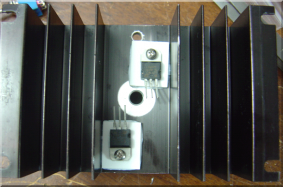 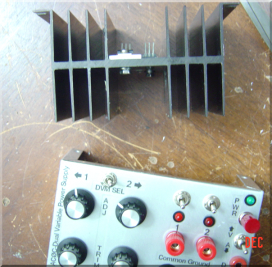 The regulator chips float above ground so they must be insulated from the heatsink. Aavid composite heatsink pads are used – they are really heavy duty and have excellent thermal conduction. The LD1084 regulator is rated at 5A as long as the thermal envelope is maintained. The regulator chips float above ground so they must be insulated from the heatsink. Aavid composite heatsink pads are used – they are really heavy duty and have excellent thermal conduction. The LD1084 regulator is rated at 5A as long as the thermal envelope is maintained.
Minimum adjustable voltage is 1.24V. But I wanted to be able to test LED without a series dropping resistor – so a set of series diodes was added at the output which provides about a 1V additional drop. Diodes are rated a 6A continuious and something like 400A surge. With the diodes, the final voltage adjustment range ended up at 0.25-28.0v total. 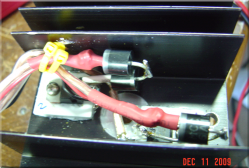
Power comes from two junkbox switching power supplies; 24v @ 2A and 6V @ 2.2A. Mounted in series, they provide 30.2v idle at about 2A overall. The LD1084 max input is 30V. The dropout of the diodes and the regulator give a 28v max output. Load test results: Min voltage, idle 0.25v Max voltage, idle 28.05v Trim knob adjustment range 2.5v 28V setting @ 160 ma 28v 28V setting @ 550ma 27.8v 28V setting @ 2.4A 27.2v (current in excess of DC supply specification) Wires to/from the regulators on the heat sink are run to the terminal strip for strain relief. 250 ohm resistors across the output ensure some current flows (the regulator is supposed to have 8mA minimum but works fine with nearly zero) for it to function properly. The two relays on the right provide DVM switching between the V mode (parallel termination) and A mode (series termination). Current is read as the voltage across the 0.1 ohm power resistor shown on the bottom right. DVM leads are in series with 250 ohm current limiting resistors to prevent damage to the DVM. The switching arrangement means the DVM can remain in a single mode (autoranging) and then the desired output (supply output #1 or #2) is selected from the PS front panel - and then the mode - V or I - is selected as well. The rest of the components shown are bypass caps.  3 paralleled RCA jacks serve as power input from the DC main power supply. The other two will allow additional external boxes to be fed by the same supply [I have plans for an external bench DVM/frequency counter module and this supply line would feed that unit]. Next on the list to make is a waveform generator and I will source the voltage for that from this tap point. The relays were needed because there was not enough room on the front panel to get a 3PDT switch mounted. And the decision to use the 0.1 ohm resistors for current measurement was added later. The layout would have been cleaner if the relays could have been avoided. 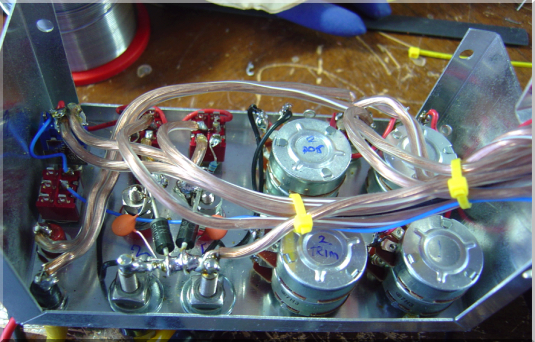
Front panel inner view shown here. All current carrying wires are 14ga. Wires are grouped together for strain relief as the top/bottom folds out for access. Dual gang pots were used because the ideal values (250 ohm + 2.5K ohm) were not found. By using 500/5K ohm dual pots in parallel, the ideal values can be realized. 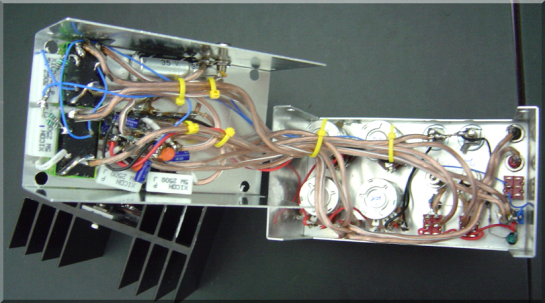 Outputs are diode clamped for reverse polarity protection and bypassed. The 3 modules shown here lay out somewhat flat on the table. The emphasis on the strain relief was very important given the number of times the design was folded shut and reopened for fit and testing. 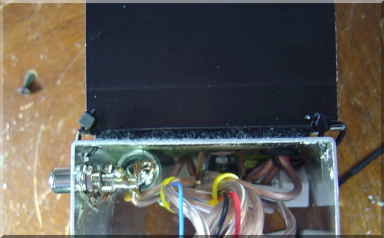 The heat sink assembly is mounted via Velcro to hold the unit in place. And then small straps secure it for the final fit. I wanted this to be easily removable so that access to the voltage setting fixed resistor was accessable without having to remove the unit from its mount. Load testing here. The DVM monitor switch reflects current on a 0.1x basis. So the 0.218v indicated is 2.18A. The fluke is mounted against bolts that hold the meter at a angle square with your eyes when seated. This model also has a battery-save auto power down eliminating a lot of battery replacements due to forgetting to turn off the meter each day. 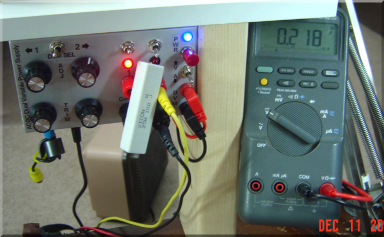 And in this position, reading voltage. The Fluke meter is autoranging which eliminates DVM switching when moving from the V to A measuring modes. And it’s 4+1 digit resolution means individual mV and mA readings are possible.  Backside mounted view. Room to put a muffin fan for further cooling, if needed. 
|